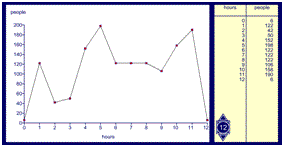Pupils should make rich connections across mathematical ideas to develop fluency, mathematical reasoning and competence in solving increasingly sophisticated problems. They should also apply their mathematical knowledge to science and other subjects.
– National Curriculum Framework Document 2013, page 9
Connections within Mathematics
Making connections to other topics within this year group
Addition and subtraction
Pupils should be taught to:
- add and subtract numbers with up to 4 digits using the formal written methods of columnar addition and subtraction where appropriate
- estimate and use inverse operations to check answers to a calculation
- solve addition and subtraction two-step problems in contexts, deciding which operations and methods to use and why.
When working on statistics and/or addition and subtraction, there are opportunities to make connections between them, for example:
The requirements for statistics include solving comparison, sum and difference problems using information presented in bar charts, pictograms, tables and other graphs. Clearly, solving such problems requires the ability to add and subtract. When covering these concepts you could provide the children with copies of bar charts, pictograms, tables and other graphs and ask them to then make up and solve problems involving addition and subtraction.
Multiplication and division
Pupils should be taught to:
- recall multiplication and division facts for multiplication tables up to 12 × 12
- use place value, known and derived facts to multiply and divide mentally, including: multiplying by 0 and 1; dividing by 1; multiplying together three numbers
- recognise and use factor pairs and commutativity in mental calculations
- multiply two-digit and three-digit numbers by a one-digit number using formal written layout
- solve problems involving multiplying and adding, including using the distributive law to multiply two digit numbers by one digit, integer scaling problems and harder correspondence problems such as n objects are connected to m objects.
- One of the requirements in multiplication and division states that children should be taught to recall multiplication and division facts for multiplication tables up to 12 × 12. You could ask the children to create bar graphs and pictograms with scales going up in step sizes that will help them to practice recalling these facts.
Making connections to this topic in adjacent year groups
Year 3
Pupils should be taught to:
- interpret and present data using bar charts, pictograms and tables
- solve one-step and two-step questions such as ‘How many more?’ and ‘How many fewer?’ using information presented in scaled bar charts and pictograms and tables
Non statutory guidance
Pupils understand and use simple scales (e.g. 2, 5, 10 units per cm) in pictograms and bar charts with increasing accuracy.
They continue to interpret data presented in many contexts.
Year 5
Pupils should be taught to
- solve comparison, sum and difference problems using information presented in a line graph
- complete, read and interpret information in tables, including timetables
Non statutory guidance
Pupils connect their work on coordinates and scales to their interpretation of time graphs.
They begin to decide which representations of data are most appropriate and why.
Cross-curricular and real life connections
Learners will encounter statistics in:
Within the science curriculum there are opportunities to connect with statistics, for example, in working scientifically there is a requirement that the children record findings using simple scientific language, drawings, labelled diagrams, keys, bar charts, and tables. In the section on living things they should identify and name a variety of living things (plants and animals) in the local and wider environment, using classification keys to assign them to groups. This can be done using tables or Venn and Carroll diagrams.
Within the geography curriculum, the children are expected to describe and understand key aspects of:
- physical geography, including: climate zones, biomes and vegetation belts, rivers, mountains, volcanoes and earthquakes, and the water cycle
- human geography, including: types of settlement and land use, economic activity including trade links, and the distribution of natural resources including energy, food, minerals and water
Give the children opportunities to gather relevant data and present it in tables, bar charts or pictograms and then analyse their findings.
